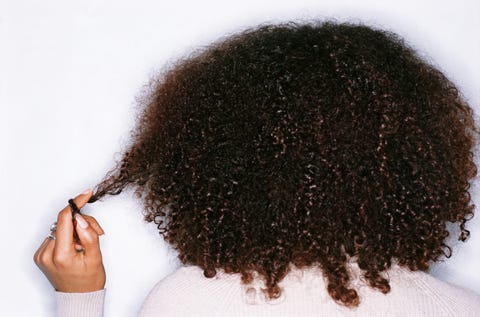Products You May Like
I was eight years old the first time I pulled out a hair. Lying on my parents’ green couch, I watched my hand rise toward my face and settle on my right eyebrow. I fingered the silky soft hairs. One was shorter, pricklier than the others. I pinched it between my thumb and index finger. I tugged.
The hair came free easily. Warmth radiated through my fingers, flooding my chest. My muscles, which had tensed the second before the pluck, relaxed. I studied the hair dangling off my fingertip. It was curved, like a crescent moon. Glossy as black ink. Before that moment, the thought of pulling out my hair would have made me squirm. But my first pluck felt as natural as breathing. This secret urge had always lived inside me, just waiting to be discovered.
I examined my new face in the mirror. In 30 minutes, three-quarters of my right eyebrow had disappeared. As much as plucking had felt right in my body, I knew from my reflection that it was wrong. A belief spawned, one that I still grapple with today, that I was wrong. For years, I thought I was the only one.
I wasn’t.
One in 50 people compulsively pull out their hair, a mental disorder called trichotillomania. Despite being relatively unknown, trichotillomania is more common than bipolar disorder and schizophrenia. People with trichotillomania may pluck from their scalp, eyebrows, eyelashes, or other body hair. Hair pulling falls under the umbrella of “body-focused repetitive behaviors” (BFRBs), which includes skin picking, cheek biting, and other body-centered behaviors. For people with BFRBs, urges to pluck hair and pick skin can feel irresistible – like the impulse to scratch a mosquito bite. Engaging in these behaviors is not self-harm. Pulling and picking feel soothing and help regulate the body’s stimulation level. Many hair pullers, myself included, pluck when we’re feeling bored or anxious – this ritualistic behavior brings us back to equilibrium.
Recently, public awareness of hair pulling has grown. On March 18, Amy Schumer released Life & Beth, a Hulu dramedy based on her own life. Amy Schumer’s character, Beth, pulls out her hair. Amy has since opened up about her real-life hair pulling, calling it “the thing that I’ve been most ashamed of.” Those familiar with her comedy know that very little is off-limits. She is as confessional and irreverent as they come. Her decades-long silence underscores the shame associated with these behaviors.
Hair is revered in our culture as an integral part of identity. Women are inundated with social messaging about the importance of long, lustrous, well-conditioned locks. Hair pulling threatens our ability to meet two crucial social norms: maintaining self-control and meeting beauty standards. Many people with trichotillomania remain in hiding their whole lives, keeping it a secret from partners and family members. I spent years believing the only thing protecting me from rejection was my eyebrow makeup or a carefully placed headband. My fear of exposure made me avoid swimming pools, social events, and dating. Even my closest friends did not know the real me, my truest self concealed beneath layers of disguise.
During a high school trip, I waded knee-deep into the ocean with my classmates. At that point, I was pulling exclusively from my scalp and wore a pixie-cut-length wig. Without warning, a wave hit me in the back of the head, sending my wig flying into the surf. Grabbing wildly underwater, I somehow came up with the wig in my fist. I dunked to conceal my bare scalp, slipping the wig back on my head. When I bobbed to the surface, my classmates appeared oblivious to my panic. For weeks after, my palms went damp and my heart pounded whenever I thought about what had happened. Though I’d never been in physical danger, it registered as a near-death experience. That’s what shame can do. Exposure feels like dying.
Socio-cultural factors exacerbate the stigma of hair pulling. Saharra Dixon, a 26-year-old Public Health PhD student at the University of Massachusetts Amherst, began pulling out her hair when she was ten years old. She plucked her pubic hair and hair from her scalp, eyebrows, and eyelashes. When Saharra’s mother noticed her bald spots, she reprimanded her, referencing her effort to make her hair “presentable.” “Before then, I hadn’t made the connection between ‘good hair’ versus ‘bad hair’ and how much money and energy Black women put into the upkeep of their hair,” Saharra says. Like many in historically marginalized communities, Saharra has experienced significant stigma around her mental health. People wondered why she couldn’t just stop and shut down her efforts to see a therapist. It wasn’t until she left home that Saharra found the help she needed.
Saharra’s therapy has involved uncovering the drivers of her pulling. Hair pulling can be motivated by various factors unique to the individual. The BFRB Precision Medicine Initiative identified three subtypes of hair pullers based on variables including sensory experience, impulsivity, and emotion regulation. Animal models, neuroimaging, and genetics are still being examined and may provide more clues about BFRBs. Cultural experiences add another layer of nuance to this already complex landscape. Saharra attended predominantly white schools growing up, causing her to feel isolated and to compare herself to others – namely, white girls with straight, easy-to-care-for hair. Dixon’s natural hair is kinky with tight coils. Much of her plucking is fueled by a desire to loosen those curls, so she can make her hair look “better and more put together.” She is now working through her texturism and colorism with a therapist. “I want to accept my crown,” she says. Unequal access to care, medical racism, and stigma within the Black community can cause Black hair pullers to feel incredibly alienated.
Cognitive behavioral therapy is currently the gold standard for treating trichotillomania. Some hair pullers find success with The Comprehensive Behavioral Model (ComB), an evidence-based treatment rooted in understanding what factors (emotional, sensory, cognitive, environmental) drive hair pulling for each person. Dr. Jon Grant, Professor of Psychiatry and Behavioral Neuroscience at the University of Chicago, notes that people with BFRBs are heterogeneous, meaning there is no one-size-fits-all approach to treatment. Medication has yielded mixed results, and a lack of funding and research participants pose barriers to identifying effective treatments. As Dr. Suzanne Mouton-Odum, a psychologist who’s treated BFRBs for almost 30 years, says, “We’re trying to study a population that’s living in the closet.” This is why celebrity advocates like Amy Schumer are so important. Greater awareness of these disorders leads to more research participants and funding, ultimately eliciting better treatments. With research like the BFRB Precision Medicine Initiative, there’s hope that BFRBs will one day become as manageable as OCD and Tourette’s Disorder.
I’m often asked, “Why can’t you just stop?” Dr. Nancy Keuthen, Director of the Trichotillomania Clinic at Massachusetts General Hospital, notes, “People wouldn’t have that expectation around other behavioral addictions, like alcoholism. If anything, BFRBs might be harder to stop because your hair and skin are always with you. BFRBs are free, the associated stress reduction or gratification is immediate, and you can do them quickly.” While hair pulling might be maladaptive from a social perspective, functionally, it is remarkably effective. Hair travels with us everywhere, providing a reliable way for pullers to ease anxiety and quell boredom. Comorbidities like depression, anxiety, substance abuse, and ADHD are also common among hair pullers, further complicating treatment. Most psychologists aren’t trained to treat BFRBs, while some remain ignorant of these behaviors altogether. And then there’s the hard reality that most people with BFRBs never seek out treatment.
Currently, remission rates for trichotillomania remain low, between 10 and 20 percent. But recovery does not necessarily require a cure. For Saharra Dixon, recovery means small victories and treating herself with grace. She still struggles with hair pulling but now has a full set of eyelashes for the first time since high school. Last year, she founded a support group for Black young adults with BFRBs, called Imani, a Swahili word meaning “faith.” She is committed to decolonizing mental health care and supporting other Black women who, like her, face obstacles related to their cultural background.
While I’ve had some success with Cognitive Behavioral Therapy and medication, the single biggest driver of my recovery is knowing I’m not alone. The TLC Foundation for BFRBs is a human services organization that supports those with BFRBs through advocacy, connection, and equitable access to evidence-based treatments. In addition to monthly health education events, they hold annual conferences bringing together hundreds of people with BFRBs, alongside psychologists and researchers. During the 2012 conference, I took off my wig in public for the first time. The experience was electrifying. Strangers became friends within seconds, wrapping me into bear hugs as they told me I was beautiful. Without my wig, I felt freer than I had since childhood. My hair loss, the same flaw I once believed alienated me from others, became a source of the deepest connections I had ever experienced. Catching glimpses of my reflection in mirrors was like seeing myself for the first time.
If feeling alone causes shame, then finding community is an antidote. Jen Monteleone, the Interim Executive Director of The TLC Foundation, put it this way: “When we’re in community with others on the same journey, we can breathe easier knowing there’s support.” Meeting other hair pullers, women who inspired me with their courage, ambition, and resilience, forced me to reevaluate my self-hate. If these women deserved love and acceptance, then why didn’t I? Within a couple of years, nearly everyone in my life knew about my hair pulling. Today, I rock a patchy buzzcut and publish personal essays about trichotillomania. I now understand that sharing vulnerabilities inspires others to do the same.
Last month, over twenty years after my first pluck, I watched Amy Schumer’s Life & Beth. I saw Beth’s hand rise toward her scalp, the pluck of one of her long blonde hairs. My eyes welled up. I was thinking about our shared pain – the pain of hiding, of feeling so utterly alone. But I was also reflecting on our shared growth. Both Amy and I had spilled our darkest secret, and in doing so, had freed ourselves from decades of silent suffering. I will likely never stop pulling out my hair. That doesn’t mean I can’t still live a full, meaningful life. Conditions like trichotillomania may not be curable. But shame is.
This content is created and maintained by a third party, and imported onto this page to help users provide their email addresses. You may be able to find more information about this and similar content at piano.io


